A Transatlantic View of the Dales Way
Two American hikers enjoy a deeper look into English culture, literature and landscapes on a four-day walk along the Dales Way.
A Transatlantic View of the Dales Way
https://www.contours.co.uk/transatlantic-dales-way
by Neall Burger
My ambitious, independent daughter Molly left art school in New York and moved to California about eight years ago. We visited the West Coast or she came east two or three times a year, but we always missed seeing her on a more regular basis.
On our last California visit, Molly suggested doing a trip with each parent separately. I have hiked before in Britain and always wanted to do an inn-to-inn trip along one of England’s famous long trails. I had been looking at the Contours website for years, fantasizing about various paths — now Molly’s offer made it a reality.
With the help of the Contours staff, I picked a four-day hike on the Dales Way, a walking holiday in Yorkshire. The staff worked out an itinerary which had us walking between 9 and 12 miles a day through fairly flat countryside.
As we rode the taxi through the rainy countryside from the train station in Skipton, the scenery got progressively wilder and more remote. The taxi driver dropped us off at The Red Lion Inn in Burnsall, where we were booked for the first night.
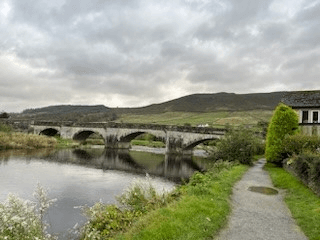
After putting down our bags in the small but comfy room, we set out to explore the village. It didn’t take long, as Burnsall is very compact and quiet and any inhabitants were probably inside preparing supper.
Burnsall is a lovely little town with stone houses, a school built in 1512, and an arched bridge over the Wharfe River.
The Red Lion is an impressive stone building first constructed as a coaching inn in the 16th century. I should say upfront that I am enthralled by old places with their centuries of use. All of the inns we stayed in were satisfyingly old, and it thrilled me to think of travellers from Jane Austen’s time — and earlier — stopping at The Red Lion for a room or a pint.
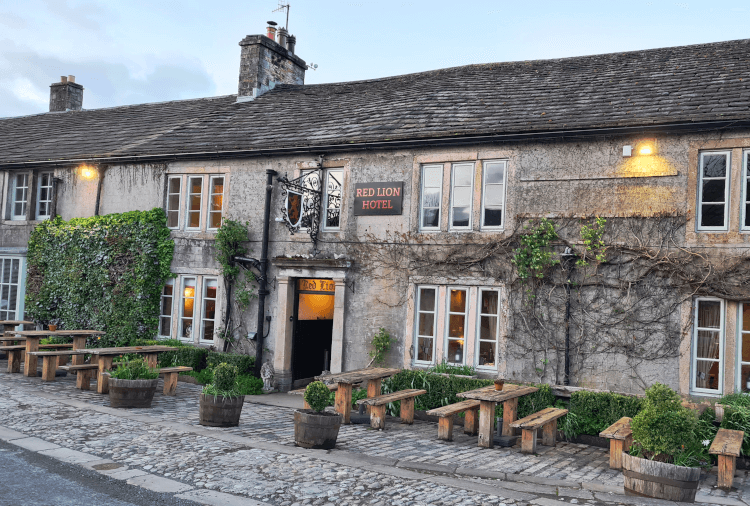
When we went to the bar for a drink before dinner, we got our first taste of the Yorkshire accent. All the British TV shows I have watched did not prepare me for how broad and, at times, incomprehensible the Yorkshire dialect is. It is remarkable that such a relatively small land mass as England has so many distinct regional dialects which remain undiluted.
We had a wonderful meal in The Red Lion’s elegant dining room. As a vegetarian, I had been a bit worried that the main dinner options would be steak and ale pie or fish and chips, but the food at every inn was excellent and all the menus had delicious vegetarian dishes.
Our first day’s walk started right out the door by the Wharfe River. We followed a level, well-tended path to Grassington, about two and a half miles away.
At one point we had to cross the river on a narrow suspension bridge, which the guidebook, with a bit of British humour, warned was not designed for obese people.
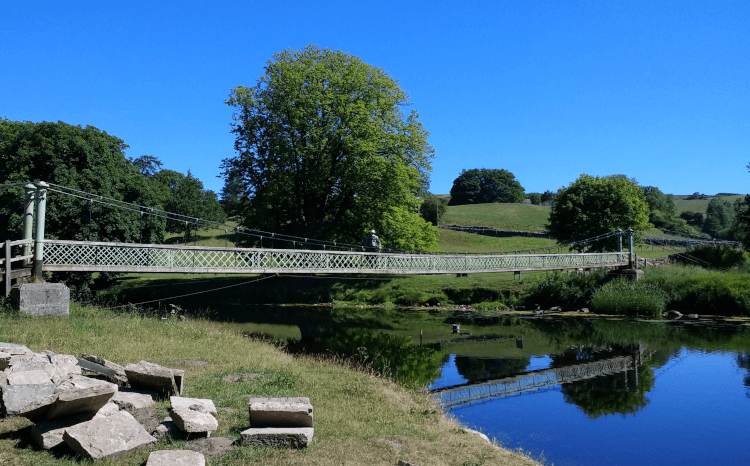
Grassington is a charming market town which obviously had a lot of tourists in the summer months as there were many quaint little shops. We found a convenience store and bought sandwiches to carry with us. That was the last open store we saw on the whole trip, and thereafter we bought packed lunches prepared at the inns.
After Grassington, we climbed a ridge to moorland: a seemingly endless expanse of rocks, grasses and stone walls with the occasional tree. Sheep abounded, all kept in their own fields by impressive, centuries-old stone walls.
Every time we passed from one field to another, we had to climb over a stile. These Yorkshire stiles consisted of two or three horizontal stone slabs sunk into the wall, then a step over the wall and two or three steps down. As the walls stood at least four feet high, the stiles required some energy to get over, and there were many stiles that first day.
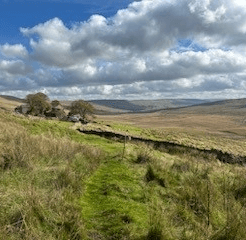
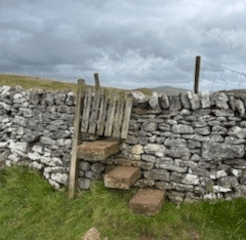
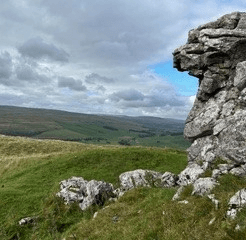
We stopped for lunch under the protection of a limestone rock outcropping called Coniston Pie and admired the sweep of the moors. Except for the sheep and us, there was no one for miles. The wind was blowing and we had put on our wool hats, but there was no place on earth I would rather have been at that moment.
We had with us an excellent guidebook and map which, as well as detailing our route, labelled every farm and crag and told us what ancient settlements were along the route. Most of Britain has been inhabited for millennia and in our four days of walking, we passed iron age settlements, Roman roads and sites of medieval villages.
Eventually we left the ridge and walked through fields (more stiles of course) and joined the Wharfedale Valley again, ending in the village of Kettlewell.
We had walked nine miles and it was only 2:00 in the afternoon, and we felt pretty pleased with ourselves. After we dropped our bags at the Blue Bell Inn, we wandered around the village.
Like many of the villages we travelled through, Kettlewell’s streets had grown in an organic fashion: basically without straight lines. Luckily Molly has a good sense of direction because I lost track of how to get back to the inn quickly, even though Kettlewell is not a big place.
There was a church with a labyrinth, which we walked; a store, which was closed; and two pubs. The houses were all made of dark stone, and even the ones which had been built for poorer workers were charming. As with Burnsall, the streets were quiet, although the Blue Bell was busy enough.
Another excellent meal, and early to bed.
We set off the next day in the direction of Outershaw. I had explained to Contours that I didn’t think I could happily walk 17.5 miles in a day, so they had accommodated us by breaking the stretches into shorter distances. We were booked into the inn at Buckden, which we would pass during the day as we walked onward to Outershaw. A taxi would take us back to Buckden, making it about ten miles.
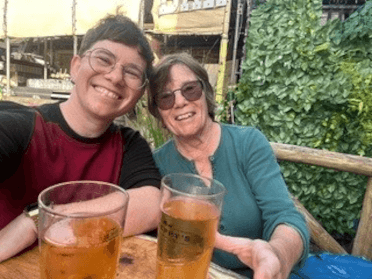
Feeling strong and adventurous, Molly suggested we cancel the taxi and walk from Outershaw back to Buckden. And this is what we did. We were lucky it was such a flat easy path because we ended up walking 14 miles that day.
The Buck Inn, where we were booked that night, was only about four miles from Kettlewell, and we stopped for a cider and sat outside in the cool sunshine. Then we headed off towards Outershaw, and had a pleasant walk by the river.
The terrain was much different from the day before. Now we were following the river again and passed through fields (more sheep) and stone buildings of all sizes. Many of these were well cared for and probably belonged to rich people who were not active farmers. I say this because they had no farm machinery and many of the windows were new.
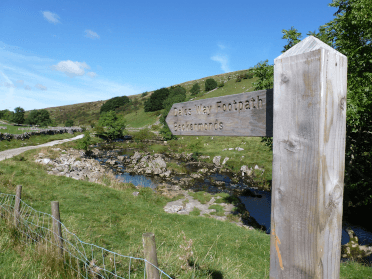
The Wharfe was getting narrower, but was still a good-sized river and looked like a good place for trout. At one point we passed a low stone circle which our guidebook said was from the bronze age.
Eventually we came to a crossroad about a mile from Outershaw and decided to turn back and retrace our steps to Buckden.
After another lovely dinner, we sat in the lounge and talked to an older couple who lived near York and spent time hiking and photographing in the Dales.
Hiking, or rambling as they call it, is much more of a tradition in Britain than it is in the States. We met several groups of older hikers who were walking fairly long distances. As someone in her mid-seventies, I found this inspiring.
The next morning, a taxi dropped us at the point where we had turned around, and we headed to Cowgill.
This stretch was the most challenging and dramatic of the hike. We quickly left the river valley and ascended into moorland. There was nothing but hills and dales covered with brownish and green grasses for as far as the eye could see.
There was a sign about planting trees as reclamation project, and we could see little groves of shoots protected by blue cones everywhere, but these were almost the only trees we saw. The footing was difficult: little hillocks on grass surrounded by mud.
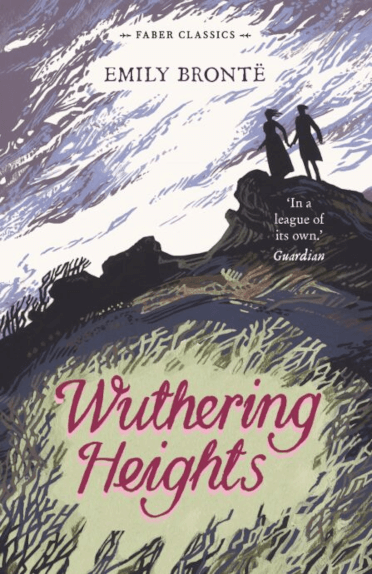
Off in the distance, perched on the top of the ridge, we could see a farm with several outbuildings and a few trees. This gave us a goal as we struggled upwards in a futile attempt to keep our feet dry.
Our guidebook told us the farm was called the Cam, and it was the most isolated farm in Yorkshire. It was exactly how I pictured Wuthering Heights and, of course, we were in Brontë country.
I have travelled in England many times, but I first fell in love with the land through literature. Jane Austen, the Brontës, Tolkien and Arthur Conan Doyle all shaped my mental map of the country.
And Molly shared my enthusiasm, though, amazingly, she had not read any of the Brontës until this trip. At times we felt we were walking through the Shire; other days, it seemed that we might see Heathcliff riding over the moors.
When we finally reached the farm, it looked empty but was still in good repair. There were two large farmhouses and several outbuildings and a single orange ATV in front.
Further on we saw several men dressed in tweeds with walking sticks, like something out of a Sherlock Holmes story. Swirling around them were English cocker spaniels, who leaped joyfully downhill, ears streaming behind them. One man stopped to explain that they were beaters scaring up partridges for wealthy hunters, who were waiting at the bottom of the hill to shoot them.
We continued up and came to a high point with a large cairn and a wooden marker pointing to the Dales Way, the Pennine Way and a bridlepath. It was the highest point for miles, with moorland and scattered trees spread out in every direction. The path led downhill into a valley, and we crossed a fairly busy road before we came to the next tussocky hillside.
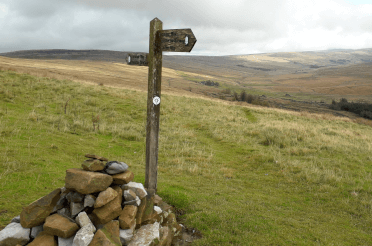
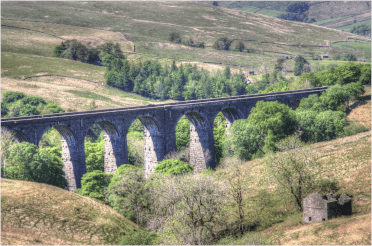
In the distance was a viaduct spanning a deep valley. It looked like a Roman aqueduct but was actually a railway bridge for the Northern Yorkshire Line. Our path lay downhill along the foot of the viaduct and into the next valley.
The path eventually levelled out and we followed a stream named the Dee. After walking several miles on a mostly deserted road, we came to The Sportsman’s Inn, our lodging for the night. It was a large stone building painted white. It was hard to miss as it was almost the only building in Cowgill.
Cowgill, it turns out, isn’t really a village but an area. It was fine with us that there was no village to explore because we were pretty tired, having walked 13 miles on uneven terrain. We had a cosy room and, we were happy to see, there was a bathtub where we could soak our weary bodies. Fittingly enough there were five cows outside our bedroom window.
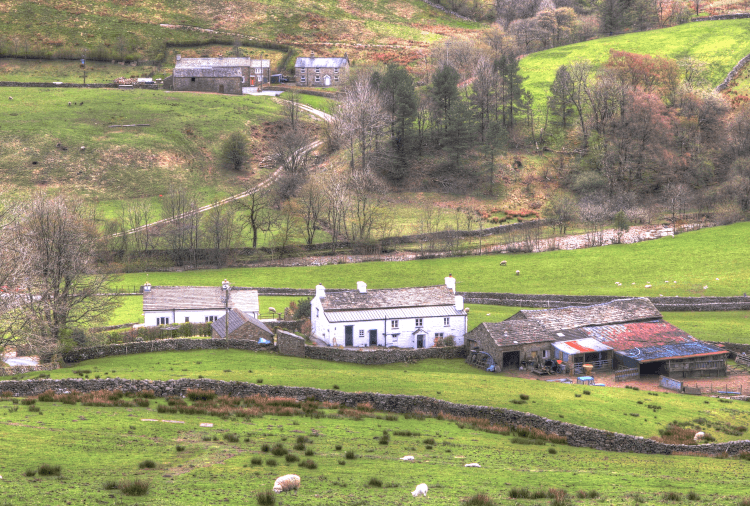
We were the only guests at the inn that night, as a group of hunters had left that morning. The publican explained to us that in the old days farmers would come in for a pint, but most of the farmers had moved away and their houses were bought by rich Londoners or others who turned the dwellings into holiday lets or only came up on the weekends. Most of his current clientele were sportsmen who came to shoot or travellers like us. He told us he and his wife had owned the pub for 40 years and they have no plans to give it up.
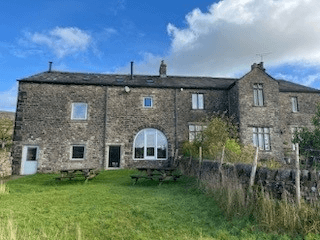
The changing population was an issue which came up with several locals we talked to, and we had noticed a number of signs for “holiday lets” in windows of the charming stone houses I liked so much.
The Dales does not look like a poor area, but obviously the population dynamic has changed over the years and many locals have needed to diversify and do jobs that cater to tourists, even if many of them still raise sheep on the side.
After another filling breakfast, we set off on our last hike from Cowgill to Sedbergh. We had been told by a fellow walker that Dent, which about four miles from Cowgill, was a lovely village and we would be able to get lunch there.
For today’s walk we were back in the Shire, with green hills, sheep and isolated stone buildings.
We passed a field with a Land Rover parked by the gate and two border collies staring intently out the back window, obviously eager to get to work rounding up sheep. Then a woman driving an ATV with two more border collies perched on back swept into the field, the dogs bracing against the turn.
I wished we could stay and watch the collies do their magic, but it could be a while before the action started.
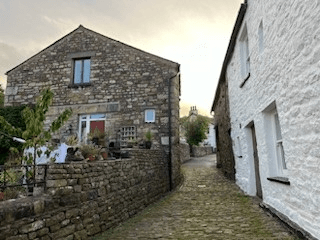
Dent appeared ahead of us — a jumble of houses with a short church tower — nestled in a shallow valley and surrounded by trees.
Dent was indeed delightful. Stone houses, many of them painted white, spread out in a haphazard manner. The cobbled streets were too narrow for cars to park so it was essentially a pedestrian village.
We stopped at a cafe and had a much better lunch than our usual packed sandwiches. Every once and awhile a woof would sound out from under a table. Dogs are allowed everywhere in Britain, even restaurants. As the owner of two dogs myself, I wish we were that accommodating at home.
Back on the road, we climbed a gentle incline towards the next valley and the town of Sedbergh.

At one point the path started to follow a wall unlike the stone walls we had climbed over before. This taller wall looked like it was it enclosed an estate, a supposition we learned was, in fact, true from a taxi driver. A number of years ago, a wealthy man had bought a large parcel of land called Gates Manor.
We never saw a house but the wall was impressively long and at least five feet high.
Sedbergh lay in a valley, and we had a long downhill approach to the town. Evidently there were no suitable lodgings in Sedbergh, so we were to meet a taxi at a pub at 4:00 for a ride back to Dent, where we were booked into a B&B.
Having walked through Dent, we were really glad of this change. Sedbergh seemed awfully busy after the solitude of last four days, and Dent was the perfect place to end our Dales Way trip.
There were two pubs in Dent, and we went to one for a drink and the other for dinner. The first pub was called The Sun and had a large gold sun painted on the outside wall. The Sun was a classic pub, not fancy but snug.
In the corner were four weatherbeaten, sinewy men with rucksacks who looked like they had probably walked our stretch of the Dales Way in two days instead of four. We did not introduce ourselves as fellow hikers.
Our next stop was York, and I had planned to take a taxi back to Skipton, but it turns out there is a train station in Dent about 4 miles out of town.
The Dent station lists itself as the highest main line station in England, being 1150 feet above sea level. It was a windswept platform with rolling hills and checkerboard fields in every direction.
We didn’t mind having to wait an hour for the train as we soaked up our last view of the Dales.
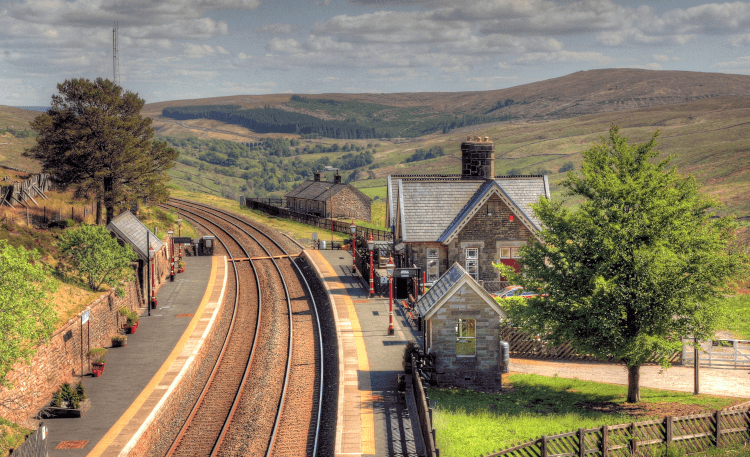
Interested in walking the Dales Way?
Contours Holidays offer three routes along the Dales Way: the complete walk; our highlights holiday, which Neall and Molly undertook; and our short break option. Find your hike here: